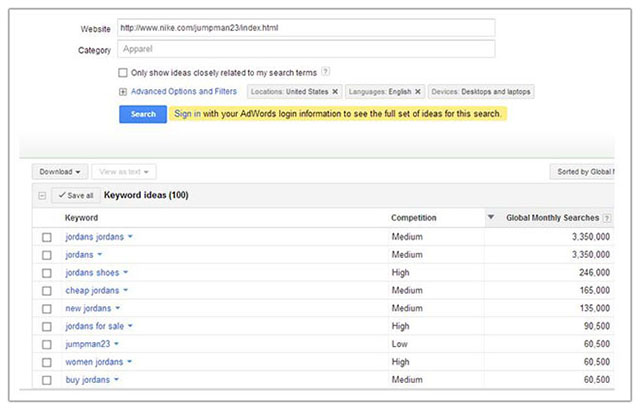Keywords research is the critical building block of any SEO & traffic building strategy. Without proper keywords, how does the right customer find you?
Consider keywords like channels. In this age of Google, different keywords are the channels through which the customers find you.
So it’s better to choose the right channel so that your products or services are a precise match to the keywords you are choosing.
And here’s how to determine your keywords:
Many entrepreneurs start out thinking they know who their target market only to be proven wrong. That’s why we have a lot of tools dedicated to do keyword research online.
Go to the places in the web where your product mentions are found. A quick easy way to do this is to search in google of course but with search operators for looking at title only.
For example, if you sell shoes online and would love to sell the latest collection of Nike Air Jordan, we can do market research to find what exactly is the customers of Nike Air Jordan are looking for. Start by searching the following.
The results in Google will show instances where Nike Air Jordan was mentioned. The results will include product pages, blog pages, comments, forum posts and just about everything that had a reference to Nike Air Jordan in the title. That’s where you can learn about the pain points of the users, what’s getting them excited, what’s getting them frustrated and so on.
Identify the exact words they are using to describe their feeling. Have a spreadsheet ready and collect whatever you think catches your eye.
This will give you an idea of the market, their language and their needs.

Now, perform a search again in Google without any modifying operators. Simply enter the terms Nike Air Jordan in Google. Get the first 10 links and analyze what keywords they are using to get themselves on the first page.
You can do this by using the Google External Keyword Tool Keyword Planner.
Login and go to Tools and Analysis – Keyword Planner and click on “Search for keyword and ad group ideas”
Copy the links of each of those 10 sites, paste them one by one into the Keyword Planner and analyse which words are used to most frequently.
Choose most searched terms among these keywords and perform searches in Google again. You will get top 10s for each of these keywords and you’ll find new sites that are ranking very well in this niche.
You can repeat this process, collect all the keywords you want. Including the low volume search keywords and download them into excel. Eliminate duplicates.
Arrange them on the order of search magnitude and arrange again based on competition score.

Repeat the process until you have exhausted of all ideas, collect as many SEO keywords, aka natural search terms as possible. Do not omit the low volume search phrases as if you target them when you are starting your content generation, you will immediately start seeing some free traffic. Yes within a month. Even if it is low, it’s free so why waste?
You can also use paid tools like LSIGraph’s Keyword Research which provides you with a powerful suite of tools to perform your keyword research.
You now should have a huge list of keywords and now is the time to prune it to keep only the targeted ones. Eliminate keywords that make no sense and discard those that are obviously not targeting your product or service.
Try to get your lists lean and as targeted as possible but at the same time try to keep even the lowest searched terms. If it has been searched once, then it will be searched again, right?
Next, prioritize your keywords, make a decision on which low volume keywords can be used for content generation to catch the so-called “low hanging fruit”. And which high competition keywords can be used as the overall focus keywords to optimize your site meta descriptions.
High volume keywords are obviously highly competitive and avoid including them in your content marketing for now. It’s pointless to compete against sites that have thousands of pages of content and have a strong brand presence and so on.
Choose the “low hanging fruit”, keywords that have very low volume, being ignored by the competition. This set of keywords, should be your first set of keywords for content marketing.
Once you have these ready, you can dive straight into developing content specifically targeting those keywords.
For example, in the earlier keyword research for Nike Air Jordan, one of the low volume keywords is “new jordans coming out”. If you do a search for that term, Nike.com, you will see the big guns like Nike.com is not listed on the top 10 results. But you can be sure that people searching for “new jordans coming out” are indeed looking for information on Nike shoes. That’s an opportunity there.
How about a blog post named, “Is Nike New Jordans Coming Out?” and a video in YouTube that says “The secret behind Nike New Jordans Coming Out This Year”. Maybe another Slide show content on scribd.com talking about “7 facts you should know before getting the New Jordans Coming Out This Week”.
And maybe list these keyword phrase under different titles in various auction sites and forums with links pointing back to your site. In a short while, you will be there on the first page attracting real people who are interested in Nike shoes.
And do you know how many people are searching for this phrase every month? over 8000 people. That’s great for less than a month old site like yours to capitalize on.
Identify plenty of such keywords. And we’ll be ready to go to the next level.